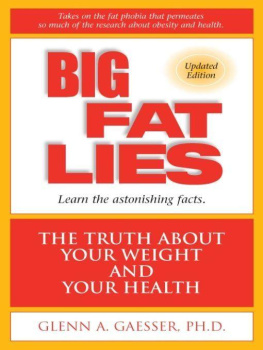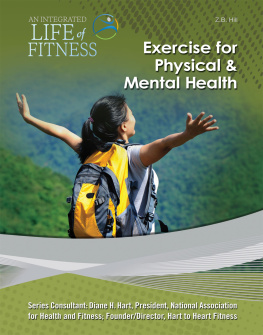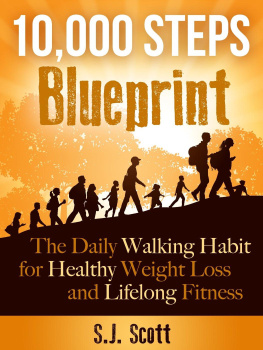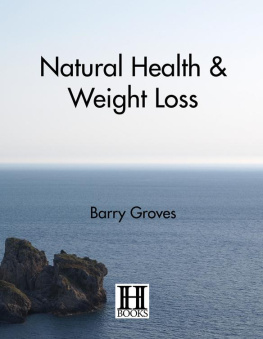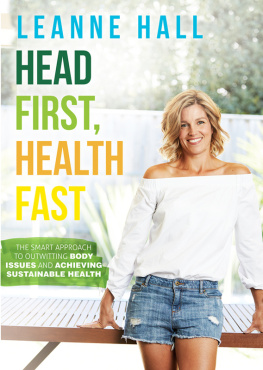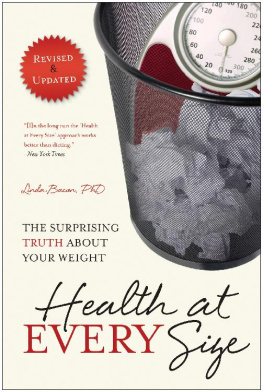Table of Contents
For my mother, Mary
thin and hypertensive,
she may well have benefited
from a few extra pounds.
ACKNOWLEDGMENTS
On the afternoon of June 17, 1972, on the campus of the University of California, Berkeley, a student delivered a speech to the graduating class of the department of physical education. It seemed appropriate that the speech focused on the role of exercise in preventive medicine, and specifically on what the graduates might contribute to society in this regard. In the speech the student proclaimed obesity is a disease and warned of its perils in much the same manner as a panel of scientists would do some thirteen years later at an NIH-sponsored conference in Bethesda, Maryland. I was that student; little did I know then that I would one day write BIG FAT LIES: The Truth About Your Weight and Your Health .
For me, the turnabout on the obesity/health issue stemmed from two things. For one, the health and vigor of many heavier-than-average men and women I encountered over the yearssome in the laboratory, some in my clinical experienceseemed to defy the dire warnings I had conveyed in my graduation speech. To those who provided living proof of this books thesis, and gave me their time and told me their stories, I am deeply indebted. However, it wasnt until I began to explore the scientific literature on the subjectas preparation for classes I taught at UCLA in the 1980s and now teach at the University of Virginiathat I realized that there was a story to tell. The end result of my explorations is this book.
Since I am not the first to challenge the mainstream view on obesity and health, I must acknowledge the works of others, for they profoundly shaped my (re)thinking on the matter. Foremost among these individuals are Ancel Keys and Reubin Andres, pioneers who were way ahead of their time; if only we had listened. Hilde Bruch ( The Importance of Overweight , in 1957), William Bennett and Joel Gurin ( The Dieters Dilemma: Eating Less and Weighing More , in 1982), Janet Polivy and C. Peter Herman ( Breaking the Diet Habit: The Natural Weight Alternative , in 1983), Hillel Schwartz ( Never Satisfied: A Cultural History of Diets, Fantasies, and Fat , in 1986), Paul Ernsberger and Paul Haskew ( Rethinking Obesity: An Alternative View of its Health Implications , in 1987), and Roberta Pollack Seid ( Never Too Thin: Why Women Are at War with Their Bodies , in 1989), also opened my eyes; their voices, too, resonate in this book.
Credit for this book must also go to my teachers, especially George Brooks, Larry Rarick, and Brian Whipp, who showed me the way of science and taught me to, above all, keep an open mind; Leonard Marascuilo, who taught me that statistics is more about common sense than about numbers; and to Bob Card, who made me realize that education is so much more than schooling.
A very special thanks to Jim Barnard and Steven Blair for sharing their time and insights, and for providing me with a steady stream of scientific evidence to help build the foundation upon which this book is based.
I thank Carol Otis, John Kral, Priscilla Clarkson, and Tim White for their careful read of the original version of the manuscript and suggestions for edits. Some of their suggestions were incorporated, and some were not. If you disagree with anything in this book, however, do not blame themI take full responsibility for presentation of the material in this book.
For their insight, inspiration, encouragement, and unwavering support of the health at every size paradigm, special thanks to Francie Berg, Debby Burgard, Paul Ernsberger, Cheri Erdman, Dayle Hayes, Joanne Ikeda, Nancy King, Karin Kratina, Pat Lyons, Lynn McAfee, and Jon Robison.
I acknowledge my agent, Lynn Seligman, who made it possible for me to get my proposal in the right hands, and I thank Jonathan Coleman for recommending her.
The finished product, of course, would not be what it is without the help of wonderful editors. My wife, Patricia, read every word of every draft of the first edition more times than she cares to remember. I believe that her editorial comments had a lot to do with the decision of Ginny Faber, my editor at Ballantine, to give a first-time author a chance. To Ginny, I say thank youfor giving me that chance, and for believing that this book has an important message. I also owe a great deal to Beth Rashbaum, who just has to be the best text editor a writer could ever want.
I also want to thank Leigh Cohn of Grze Books for providing me the opportunity to publish this updated version of BIG FAT LIES, and Elaine Moore for her wonderful editing skills.
The research and writing of this book took the better part of five years. It made for a lot of late nights and working weekends. Through it all, my family was tremendously supportive. To Patricia and my terrific children, Mike, Lindsay, and Brandon, thanks for your patience and understandingyou make it all worthwhile.
Finally, my deepest thanks to my parents, Mary and Richard, for making it all possible.
FOREWORD
by Steven N. Blair, PED
Director of Research, The Cooper Institute for Aerobics Research; Senior Scientific Editor, Surgeon Generals Report on Physical Activity and Health
Millions of Americans, most of them women, step on the bathroom scale each morning and let it dictate the kind of day they will have. If their weight is down a pound or two, it will be a good day; if its up a pound, the day is already off to a bad start. So it goes in a thin is in culture that has brainwashed us to believe that the numbers on the bathroom scale tell us something meaningful about our worth. Americans spend tens of billions of dollars each year in an effort to lose weight, tryingmostly in vainto conform to the cultural standard of the ideal or desirable body shape, which, at least for women, has become progressively thinner over the past few decades. Unfortunately, the average American woman (and man, for that matter) is heavier now than ever before, which means that a good many of us are having quite a few bad scale days.
While these bad scale days are damaging to our self-esteem and our emotional well-being, much of what is written about the everwidening gap between what we actually weigh and what we are told we should weigh focuses on health. It is at this issuethe alleged health hazard of being overweightthat BIG FAT LIES: The Truth about Your Weight and Your Health , takes aim. And it is right on target. One of the most firmly held and widely accepted views in the weight loss industry and in medical circles is that overweight itself constitutes a major health crisis, and that weight loss in overweight individuals results in improved health and better chances for avoiding premature death.
Herein lies the paradox. It is absolutely clear that elevated blood pressure and cholesterol can cause heart attacks and other health problems. It is also well-established that weight loss, even in those only mildly overweight, will lower blood pressure and cholesterol. Therefore, it seems logical to conclude that weight loss in overweight individuals will reduce their risk of heart attack, stroke, diabetes, perhaps some types of cancer, and of death from these diseases. It should follow that if a large population of overweight individuals have their weight measured over time, those who lose weight would be less likely to suffer premature death from cardiovascular diseases and other causes than those who do not lose weight. Furthermore, we might expect that when overweight individuals gain even more weight, they are more likely to die prematurely than overweight persons who do not. Yet these expectations, as Dr. Gaessers book makes strikingly clear, are not wellsupported by existing studies.

